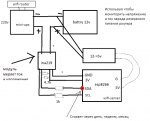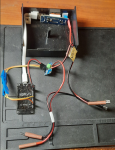Огромное спасибо, что столько человек оперативно отреагировало!
Прикладываю фото. Номинал всех резисторов проверял. 1ком резисторы в изоленте внутри, думал буду подбирать номинал, там вставлен в дюпоны просто. Изолента фиксирует дополнительно.
О земле. Тестор звенит от черной клеммы, где аккумулятор подсоединяет и аж до INA219 земли. Т.е. проходит: аккумулятор, 12->5 эта платка с индикатором, ESP8266, INA219.
Температуру я не мерял после пробоя, чип ESP8266 не трогал.
Как я проверяю схему? Никак, у меня опыта нет. Просто собрал, и работает. Когда сгорают пины, беру следующие живые.
Если кто-то научит, я буду благодарен. Уже есть осциллограф (увидел как по спаду данные идут по i2c - но что это мне дало? там 3 с чем-то вольт, не было 12в или такого чего-то). Я начинающий любитель в этом деле.
>INA219 может работать и от 5В. ESP от этого не холодно, не жарко.
Когда сгорела в первый раз, я INA219 питал 5в, потом стал 3.3в (подумал, может INA219 начала 5в мне отправлять на 3.3в вход ESP). Я тогда не знал что I2C при посылке на землю прижимает сигнал.
Второй раз сгорела, я прицепил подтягивающий резисторы 4.7ком (их не было вообще, не знал).
Третий, прицепил эти токо-ограничивающие на 1ком.
>сэкономили на резисторах.
поставить 2ком?
Скетч:
#include <ESP8266WiFi.h>
#include <WiFiClient.h>
#include <ESP8266WebServer.h>
#include <ESP8266mDNS.h>
#include <Wire.h>
#include <Adafruit_INA219.h>
#ifndef STASSID
#define STASSID "xxx"
#define STAPSK "yyy"
#endif
const char* ssid = STASSID;
const char* password = STAPSK;
ESP8266WebServer server(80);
Adafruit_INA219 ina219;
//const int led = 15;
void SendIna219();
void handleRoot() {
SendIna219();
}
void handleNotFound() {
String message = "File Not Found\n\n";
message += "URI: ";
message += server.uri();
message += "\nMethod: ";
message += (server.method() == HTTP_GET) ? "GET" : "POST";
message += "\nArguments: ";
message += server.args();
message += "\n";
for (uint8_t i = 0; i < server.args(); i++) { message += " " + server.argName(i) + ": " + server.arg(i) + "\n"; }
server.send(404, "text/plain", message);
}
void setup(void) {
Serial.begin(115200);
Serial.print("Hello? ");
delay(500);
Wire.begin(14, 4);
if (! ina219.begin(&Wire)) {
Serial.println("Failed to find INA219 chip");
while (1) { delay(10); }
}
WiFi.mode(WIFI_STA);
WiFi.begin(ssid, password);
Serial.println("");
// Wait for connection
while (WiFi.status() != WL_CONNECTED) {
delay(500);
Serial.print(".");
}
Serial.println("");
Serial.print("Connected to ");
Serial.println(ssid);
Serial.print("IP address: ");
Serial.println(WiFi.localIP());
if (MDNS.begin("esp8266")) { Serial.println("MDNS responder started"); }
server.on("/", handleRoot);
server.on("/inline", []() {
server.send(200, "text/plain", "this works as well");
});
server.on("/gif", []() {
static const uint8_t gif[] PROGMEM = {
0x47, 0x49, 0x46, 0x38, 0x37, 0x61, 0x10, 0x00, 0x10, 0x00, 0x80, 0x01,
0x00, 0x00, 0x00, 0x00, 0xff, 0xff, 0xff, 0x2c, 0x00, 0x00, 0x00, 0x00,
0x10, 0x00, 0x10, 0x00, 0x00, 0x02, 0x19, 0x8c, 0x8f, 0xa9, 0xcb, 0x9d,
0x00, 0x5f, 0x74, 0xb4, 0x56, 0xb0, 0xb0, 0xd2, 0xf2, 0x35, 0x1e, 0x4c,
0x0c, 0x24, 0x5a, 0xe6, 0x89, 0xa6, 0x4d, 0x01, 0x00, 0x3b
};
char gif_colored[sizeof(gif)];
memcpy_P(gif_colored, gif, sizeof(gif));
// Set the background to a random set of colors
gif_colored[16] = millis() % 256;
gif_colored[17] = millis() % 256;
gif_colored[18] = millis() % 256;
server.send(200, "image/gif", gif_colored, sizeof(gif_colored));
});
server.onNotFound(handleNotFound);
/////////////////////////////////////////////////////////
// Hook examples
server.addHook([](const String& method, const String& url, WiFiClient* client, ESP8266WebServer::ContentTypeFunction contentType) {
(void)method; // GET, PUT, ...
(void)url; // example: /root/myfile.html
(void)client; // the webserver tcp client connection
(void)contentType; // contentType(".html") => "text/html"
Serial.printf("A useless web hook has passed\n");
Serial.printf("(this hook is in 0x%08x area (401x=IRAM 402x=FLASH))\n", esp_get_program_counter());
return ESP8266WebServer::CLIENT_REQUEST_CAN_CONTINUE;
});
server.addHook([](const String&, const String& url, WiFiClient*, ESP8266WebServer::ContentTypeFunction) {
if (url.startsWith("/fail")) {
Serial.printf("An always failing web hook has been triggered\n");
return ESP8266WebServer::CLIENT_MUST_STOP;
}
return ESP8266WebServer::CLIENT_REQUEST_CAN_CONTINUE;
});
server.addHook([](const String&, const String& url, WiFiClient* client, ESP8266WebServer::ContentTypeFunction) {
if (url.startsWith("/dump")) {
Serial.printf("The dumper web hook is on the run\n");
// Here the request is not interpreted, so we cannot for sure
// swallow the exact amount matching the full request+content,
// hence the tcp connection cannot be handled anymore by the
// webserver.
#ifdef STREAMSEND_API
// we are lucky
client->sendAll(Serial, 500);
#else
auto last = millis();
while ((millis() - last) < 500) {
char buf[32];
size_t len = client->read((uint8_t*)buf, sizeof(buf));
if (len > 0) {
Serial.printf("(<%d> chars)", (int)len);
Serial.write(buf, len);
last = millis();
}
}
#endif
// Two choices: return MUST STOP and webserver will close it
// (we already have the example with '/fail' hook)
// or IS GIVEN and webserver will forget it
// trying with IS GIVEN and storing it on a dumb WiFiClient.
// check the client connection: it should not immediately be closed
// (make another '/dump' one to close the first)
Serial.printf("\nTelling server to forget this connection\n");
static WiFiClient forgetme = *client; // stop previous one if present and transfer client refcounter
return ESP8266WebServer::CLIENT_IS_GIVEN;
}
return ESP8266WebServer::CLIENT_REQUEST_CAN_CONTINUE;
});
// Hook examples
/////////////////////////////////////////////////////////
server.begin();
Serial.println("HTTP server started");
}
void loop(void) {
server.handleClient();
MDNS.update();
}
//server.send(200, "text/plain", "hello Natasha!\r\n");
void SendIna219()
{
float shuntvoltage = 0;
float busvoltage = 0;
float current_mA = 0;
float loadvoltage = 0;
float power_mW = 0;
float coeff = 1.0;
shuntvoltage = ina219.getShuntVoltage_mV();
busvoltage = ina219.getBusVoltage_V();
current_mA = ina219.getCurrent_mA();
power_mW = ina219.getPower_mW();
loadvoltage = busvoltage + (shuntvoltage / 1000);
char buf[1024] = { 0 };
char tmp[128];
if (current_mA < 0)
{
strcat(buf, "Status: 220v\r\n");
} else
{
strcat(buf, "Status: battery backup\r\n");
}
strcat(buf, "\r\n");
sprintf(tmp, "Bus Voltage: %.2f V\r\n", busvoltage);
strcat(buf, tmp);
sprintf(tmp, "Shunt Voltage: %.2f mV\r\n", shuntvoltage);
strcat(buf, tmp);
sprintf(tmp, "Load Voltage: %.2f V\r\n", loadvoltage);
strcat(buf, tmp);
sprintf(tmp, "Current: %.1f A\r\n", abs(current_mA / 1000.0));
strcat(buf, tmp);
sprintf(tmp, "Power: %.1f W\r\n", power_mW / 1000.0);
strcat(buf, tmp);
server.send(200, "text/plain", buf);
}









